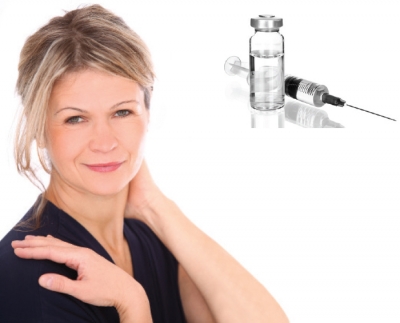
A recent study found that aging skin was more related to a slowed cellular process, cigarette smoking, and collagen changes in the dermis, than to a loss of estrogen. Studying the results discovers that by viewing bone compression in the face, “deepening and worsening skin wrinkles are related to lower bone density.” As our facial bones compress, they contribute to a loss of cheek “apples” and the sallow look of the face.
2.Hormone therapy is a way to replenish lost female hormones in order to help prevent the many discomforts of menopause. Many women often dismiss hormone therapy due to its potentially dangerous effects. However, more recent research found that hormone therapy could be a safe treatment for women in their late 40s to early 50s, just entering menopause. A woman experiencing pre-menopausal symptoms should discuss the possible solutions with her doctor.
 3.Men can receive testosterone therapy for a condition called hypogonadism (testosterone deficiency). Unfortunately, some men see testosterone supplements as a way to defy aging, sagging muscles, and improve sex drive, resulting in off-label use of the prescription. There are increased cardiovascular risks that need to be considered, which is why the FDA recently imposed new strict limitations on the booming testosterone drug in order to deter its use for anti-aging.
3.Men can receive testosterone therapy for a condition called hypogonadism (testosterone deficiency). Unfortunately, some men see testosterone supplements as a way to defy aging, sagging muscles, and improve sex drive, resulting in off-label use of the prescription. There are increased cardiovascular risks that need to be considered, which is why the FDA recently imposed new strict limitations on the booming testosterone drug in order to deter its use for anti-aging.
4.The very expensive human growth hormone (HGH) injection craze in men and women began not too long ago with celebrities touting its benefits for common aging problems. It was originally created to help children and adults suffering from pituitary disorder and HIV-AIDS-related muscle loss. Research is limited on the long-term effects in adults, but the hormone does have potential risks.
5.Estrogen and progesterone fluctuations, or thyroid disorders may be responsible for dry, brittle, or flaky skin. Dry skin is common and can also be a result of environment, lifestyle, slowed cellular processes, and hormonal changes. Hydration and moisture are essential to help keep the skin’s barrier intact and prevent fine lines and dehydration. Some key moisturizer ingredients include shea butter, squalane, cetyl alcohol, nut oils, and petrolatum. A low dose of topical progesterone United States Pharmacopeia (USP) may help promote moisture retention in some cases. Exfoliation and regeneration with an alpha hydroxy acid and topical retinoid may be beneficial in improving poor desquamation process and the overall radiance of the skin. Sell these products with caution as they can also increase sensitivity or trigger inflammation.
 6.Melasma may be attributed to estrogen and progesterone fluctuations during pregnancy, postpartum/breastfeeding, oral contraceptives, or premenopausal. This condition is not only stimulated by ultraviolet radiation, but also heat and trauma (chemical treatments, lasers, or cuts) to the skin, making it a challenge to treat without suppression of the melanocytes. Some clients may show light symptoms of discoloration that may be manageable with a good lightening home regimen and aesthetic treatments. Others will have suffered from deep-rooted pigmentation by having used for years the prescription retinol and hydroquinone at home to manage the condition. In many cases, the client has either been using the prescriptions too long and they have become ineffective, or the products are overused or the dose is too high, triggering inflammation and stimulating more pigmentation. Helping the client manage her prescriptions with her physician’s advice and adding products that help calm the skin and suppress melanin will be of assistance.
6.Melasma may be attributed to estrogen and progesterone fluctuations during pregnancy, postpartum/breastfeeding, oral contraceptives, or premenopausal. This condition is not only stimulated by ultraviolet radiation, but also heat and trauma (chemical treatments, lasers, or cuts) to the skin, making it a challenge to treat without suppression of the melanocytes. Some clients may show light symptoms of discoloration that may be manageable with a good lightening home regimen and aesthetic treatments. Others will have suffered from deep-rooted pigmentation by having used for years the prescription retinol and hydroquinone at home to manage the condition. In many cases, the client has either been using the prescriptions too long and they have become ineffective, or the products are overused or the dose is too high, triggering inflammation and stimulating more pigmentation. Helping the client manage her prescriptions with her physician’s advice and adding products that help calm the skin and suppress melanin will be of assistance.
 7.Acne is a condition of the pilosebaceous unit that has been attributed to androgen imbalances in the body, but research continues to help find a cause for problem skin. It is important to provide honest advice as acne can be an emotional and a physical problem. It cannot be cured, only managed with diligent homecare and professional care. Depending on the severity of acne and whether or not it is inflamed, topical prescription retinoids, oral antibiotics, and/or oral contraceptives can be instrumental in preventing inflammation, making aesthetic treatments and client education a productive process.
7.Acne is a condition of the pilosebaceous unit that has been attributed to androgen imbalances in the body, but research continues to help find a cause for problem skin. It is important to provide honest advice as acne can be an emotional and a physical problem. It cannot be cured, only managed with diligent homecare and professional care. Depending on the severity of acne and whether or not it is inflamed, topical prescription retinoids, oral antibiotics, and/or oral contraceptives can be instrumental in preventing inflammation, making aesthetic treatments and client education a productive process.
 8.Hair growth on the face and body of women can give signs to an underlying hormonal imbalance. Women may begin to grow hair on the lip and chin, while losing hair on the pubic region, underarms, and legs. During pregnancy, an increase in hair count along the inner thighs and abdomen may occur. Women suffering from hirsutism or polycystic ovarian syndrome can present with excessive terminal hair over many parts of the body and face. Even with laser hair reduction treatments, results may not last or be as expected without management of the condition with a physician. Overall, advising clients about the best hair removal options is good service. Waxing can be an effective and inexpensive means to help thin and soften hair growth, while electrolysis is the only FDA-approved means of hair removal.
8.Hair growth on the face and body of women can give signs to an underlying hormonal imbalance. Women may begin to grow hair on the lip and chin, while losing hair on the pubic region, underarms, and legs. During pregnancy, an increase in hair count along the inner thighs and abdomen may occur. Women suffering from hirsutism or polycystic ovarian syndrome can present with excessive terminal hair over many parts of the body and face. Even with laser hair reduction treatments, results may not last or be as expected without management of the condition with a physician. Overall, advising clients about the best hair removal options is good service. Waxing can be an effective and inexpensive means to help thin and soften hair growth, while electrolysis is the only FDA-approved means of hair removal.
 9.The biggest obstacle in treating conditions that may be hormonally-stimulated is client compliance. When the body is imbalanced and the client wants to see a dramatic improvement in their skin, the client must seek medical advice from their physician, gynecologist, or endocrinologist – then follow it. Without promoting a change internally, treating hormone-induced skin conditions becomes a type of tug of war that the body eventually wins. Fortunately, a combination of medical and aesthetic care can help improve the outlook of acne, melasma, dry skin, and awry hair growth.
9.The biggest obstacle in treating conditions that may be hormonally-stimulated is client compliance. When the body is imbalanced and the client wants to see a dramatic improvement in their skin, the client must seek medical advice from their physician, gynecologist, or endocrinologist – then follow it. Without promoting a change internally, treating hormone-induced skin conditions becomes a type of tug of war that the body eventually wins. Fortunately, a combination of medical and aesthetic care can help improve the outlook of acne, melasma, dry skin, and awry hair growth.
10.Stay calm, tranquil, and composed when analyzing and consulting a client who presents with a hormonal skin condition. Chemical peels, microdermabrasion, and lasers all induce trauma, trigger inflammation, and agitate skin conditions – especially acne and melasma. Always err on the side of caution when treating hormonally-challenged skin.
Every skin care professional should have a basic knowledge of hormonal considerations. Without considerations for hormonal variables, inexperience and poor client care will outweigh the ability to effectively treat the condition. The most essential part of client care is creating a balanced homecare regimen and treatment timeline, while addressing the potential for hormonal imbalances. The timeline begins with a consultation and ends with a commitment to homecare, monthly treatments, and a visit to their physician to explore a means for dramatic improvement to their skin and body.
 Tina Zillmann is the founder of Advanced Rejuvenating Concepts and Skin Rejuvenation Clinique. As a business owner, aesthetician, product developer, and licensed laser professional, she is fluent on all aspects of the aesthetic business. She has been awarded on television and print as a local skin care expert in San Antonio, Texas and nationally as a public speaker and published writer in the skin care industry.
Tina Zillmann is the founder of Advanced Rejuvenating Concepts and Skin Rejuvenation Clinique. As a business owner, aesthetician, product developer, and licensed laser professional, she is fluent on all aspects of the aesthetic business. She has been awarded on television and print as a local skin care expert in San Antonio, Texas and nationally as a public speaker and published writer in the skin care industry.



















